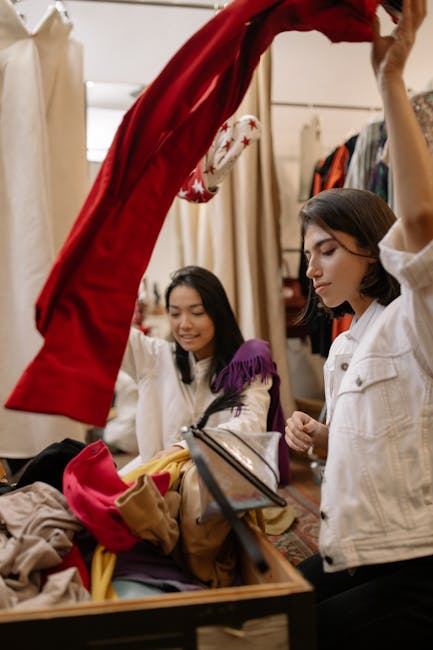The Rise of Thrift Shopping

Thrift shopping, once seen as a niche activity, is now gaining mainstream attention in America. This surge can be attributed to several factors including economic constraints, environmental awareness, and a growing desire for unique fashion. As the cost of living rises, many Americans are seeking out more affordable alternatives to traditional retail shopping. Thrift stores offer a treasure trove of gently-used clothing at a fraction of the cost. Additionally, with the increasing focus on sustainability, more consumers are turning to thrift shopping as a way to reduce their carbon footprint. The appeal of finding one-of-a-kind pieces that reflect personal style is also drawing more fashion enthusiasts to thrift stores.
Sustainability in Fashion

The fashion industry is notorious for its significant environmental impact. Thrift shopping presents an eco-friendly alternative by promoting the reuse and recycling of clothing. By purchasing second-hand items, consumers are helping to reduce the demand for new clothing production, which in turn decreases pollution and waste. The concept of a circular economy in fashion is gaining traction, and thrift shopping is at the forefront of this movement. It encourages a shift from the traditional linear fashion model to a more sustainable one, where clothes are reused and repurposed rather than discarded after a single use.
Economic Benefits for Consumers

One of the most compelling aspects of thrift shopping is the economic benefit it offers consumers. In a world where fast fashion often comes with a hefty price tag, thrift stores provide an affordable alternative. Shoppers can find high-quality, designer items at a fraction of their original cost. This affordability allows individuals from various economic backgrounds to access fashion that might otherwise be out of reach. Furthermore, by shopping at thrift stores, consumers are not only saving money but also supporting local charities and community initiatives, as many thrift stores are run by nonprofit organizations.
The Role of Technology

Technology is playing a significant role in the evolution of thrift shopping. Online platforms and apps dedicated to buying and selling second-hand clothing are making it easier than ever for consumers to participate in this trend. Websites like Poshmark and Depop have transformed the thrift shopping experience, allowing users to browse and purchase items from the comfort of their homes. These platforms also provide a space for individuals to sell their own clothing, further promoting the circular fashion economy. The integration of technology in thrift shopping has broadened its reach, attracting a younger, tech-savvy audience.
Unique Fashion Finds

Thrift shopping offers a unique opportunity for individuals to express their personal style. Unlike fast fashion, which often promotes uniformity, thrift stores are filled with diverse, eclectic pieces. Shoppers can find vintage clothing, rare designer items, and one-of-a-kind accessories that aren’t available in mainstream retail stores. This diversity allows individuals to curate a wardrobe that is truly reflective of their personality and taste. The thrill of discovering hidden gems in thrift stores adds an element of excitement and creativity to the shopping experience.
Influence on Mainstream Fashion

Thrift shopping is having a noticeable impact on mainstream fashion. Designers and brands are increasingly drawing inspiration from vintage and second-hand styles. This influence can be seen in the resurgence of retro trends, such as 90s grunge and 70s boho, in current fashion collections. Thrift shopping has also encouraged a more inclusive approach to fashion, with a focus on individuality and sustainability. As more people embrace second-hand shopping, the fashion industry is being challenged to rethink its practices and adapt to changing consumer preferences.
Challenges and Misconceptions

Despite its many benefits, thrift shopping is not without its challenges. There are misconceptions that thrift stores only carry outdated or low-quality items. However, this couldn’t be further from the truth. Thrift stores often stock high-quality, gently-used clothing that has been carefully curated. Another challenge is the stigma associated with second-hand shopping, which is slowly changing as more people recognize its value. The key to a successful thrift shopping experience is patience and an open mind, as finding the perfect piece may require some digging.
Thrift Shopping and Youth Culture

Thrift shopping has become particularly popular among younger generations. Millennials and Gen Z are leading the charge towards more sustainable fashion choices, and thrift stores are a natural fit for their values. This demographic is drawn to the affordability, uniqueness, and environmental benefits of thrift shopping. Social media platforms like Instagram and TikTok have also played a role in popularizing thrift shopping among youth, with influencers and fashion bloggers showcasing their thrifted finds and inspiring others to follow suit.
Community Impact

Thrift shopping has a positive impact on local communities. Many thrift stores are operated by nonprofit organizations that use proceeds to fund charitable initiatives. By shopping at these stores, consumers are directly supporting causes such as homelessness, education, and healthcare. Thrift stores also provide employment opportunities and contribute to the local economy. The sense of community fostered by thrift shopping is one of its most rewarding aspects, as it connects individuals through shared values and a common goal of sustainability.
The Future of Thrift Shopping

The future of thrift shopping looks promising as more people become aware of its benefits. As the fashion industry continues to evolve, thrift shopping is likely to play an increasingly important role in shaping consumer behavior. The shift towards sustainable, ethical fashion is gaining momentum, and thrift shopping aligns perfectly with these values. With continued growth in technology, online platforms, and consumer awareness, thrift shopping is set to reshape the future of American fashion in a meaningful way. This movement towards thrift shopping represents a significant step forward in creating a more sustainable and inclusive fashion industry.







